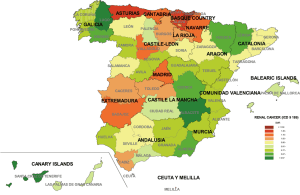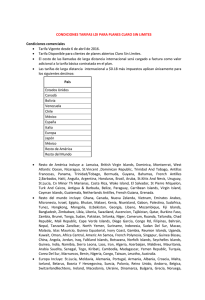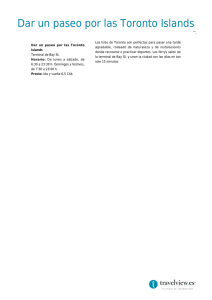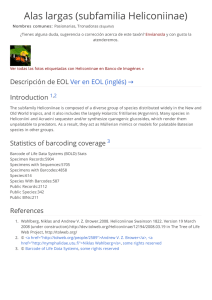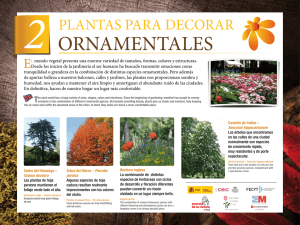PRIORITIZING RESTORATION ACTIONS FOR THE ISLANDS OF
Anuncio
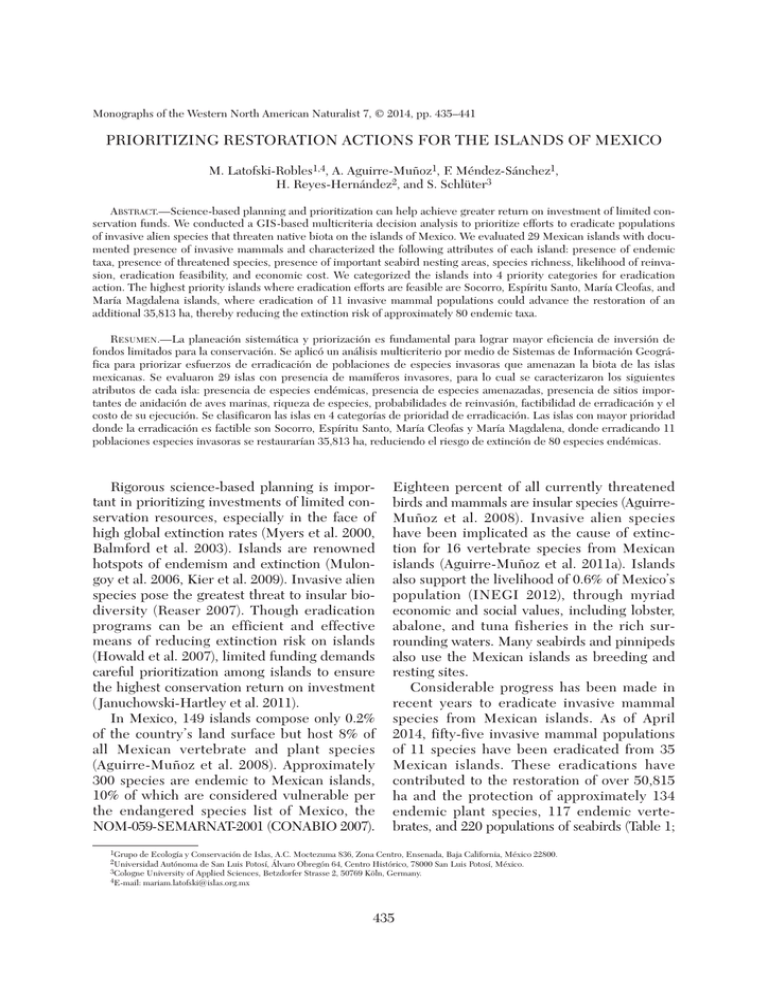
Monographs of the Western North American Naturalist 7, © 2014, pp. 435–441 PRIORITIZING RESTORATION ACTIONS FOR THE ISLANDS OF MEXICO M. Latofski-Robles1,4, A. Aguirre-Muñoz1, F. Méndez-Sánchez1, H. Reyes-Hernández2, and S. Schlüter3 ABSTRACT.—Science-based planning and prioritization can help achieve greater return on investment of limited conservation funds. We conducted a GIS-based multicriteria decision analysis to prioritize efforts to eradicate populations of invasive alien species that threaten native biota on the islands of Mexico. We evaluated 29 Mexican islands with documented presence of invasive mammals and characterized the following attributes of each island: presence of endemic taxa, presence of threatened species, presence of important seabird nesting areas, species richness, likelihood of reinvasion, eradication feasibility, and economic cost. We categorized the islands into 4 priority categories for eradication action. The highest priority islands where eradication efforts are feasible are Socorro, Espíritu Santo, María Cleofas, and María Magdalena islands, where eradication of 11 invasive mammal populations could advance the restoration of an additional 35,813 ha, thereby reducing the extinction risk of approximately 80 endemic taxa. RESUMEN.—La planeación sistemática y priorización es fundamental para lograr mayor eficiencia de inversión de fondos limitados para la conservación. Se aplicó un análisis multicriterio por medio de Sistemas de Información Geográfica para priorizar esfuerzos de erradicación de poblaciones de especies invasoras que amenazan la biota de las islas mexicanas. Se evaluaron 29 islas con presencia de mamíferos invasores, para lo cual se caracterizaron los siguientes atributos de cada isla: presencia de especies endémicas, presencia de especies amenazadas, presencia de sitios importantes de anidación de aves marinas, riqueza de especies, probabilidades de reinvasión, factibilidad de erradicación y el costo de su ejecución. Se clasificaron las islas en 4 categorías de prioridad de erradicación. Las islas con mayor prioridad donde la erradicación es factible son Socorro, Espíritu Santo, María Cleofas y María Magdalena, donde erradicando 11 poblaciones especies invasoras se restaurarían 35,813 ha, reduciendo el riesgo de extinción de 80 especies endémicas. Rigorous science-based planning is important in prioritizing investments of limited conservation resources, especially in the face of high global extinction rates (Myers et al. 2000, Balmford et al. 2003). Islands are renowned hotspots of endemism and extinction (Mulongoy et al. 2006, Kier et al. 2009). Invasive alien species pose the greatest threat to insular biodiversity (Reaser 2007). Though eradication programs can be an efficient and effective means of reducing extinction risk on islands (Howald et al. 2007), limited funding demands careful prioritization among islands to ensure the highest conservation return on investment (Januchowski-Hartley et al. 2011). In Mexico, 149 islands compose only 0.2% of the country’s land surface but host 8% of all Mexican vertebrate and plant species (Aguirre-Muñoz et al. 2008). Approximately 300 species are endemic to Mexican islands, 10% of which are considered vulnerable per the endangered species list of Mexico, the NOM-059-SEMARNAT-2001 (CONABIO 2007). Eighteen percent of all currently threatened birds and mammals are insular species (AguirreMuñoz et al. 2008). Invasive alien species have been implicated as the cause of extinction for 16 vertebrate species from Mexican islands (Aguirre-Muñoz et al. 2011a). Islands also support the livelihood of 0.6% of Mexico’s population (INEGI 2012), through myriad economic and social values, including lobster, abalone, and tuna fisheries in the rich surrounding waters. Many seabirds and pinnipeds also use the Mexican islands as breeding and resting sites. Considerable progress has been made in recent years to eradicate invasive mammal species from Mexican islands. As of April 2014, fifty-five invasive mammal populations of 11 species have been eradicated from 35 Mexican islands. These eradications have contributed to the restoration of over 50,815 ha and the protection of approximately 134 endemic plant species, 117 endemic vertebrates, and 220 populations of seabirds (Table 1; 1Grupo de Ecología y Conservación de Islas, A.C. Moctezuma 836, Zona Centro, Ensenada, Baja California, México 22800. 2Universidad Autónoma de San Luis Potosí, Álvaro Obregón 64, Centro Histórico, 78000 San Luis Potosí, México. 3Cologne University of Applied Sciences, Betzdorfer Strasse 2, 50769 Köln, Germany. 4E-mail: [email protected] 435 436 MONOGRAPHS OF THE WESTERN NORTH AMERICAN NATURALIST [Volume 7 TABLE 1. Mexican islands with successful eradication projects. Island Pacific Ocean Asunción Clarión Coronado Norte Coronado Sur Guadalupe Guadalupe Guadalupe Area (ha) 41 1958 37 126 24,171 Guadalupe Guadalupe Natividad 736 Natividad San Benito Este San Benito Medio San Benito Oeste 146 45 364 San Jerónimo San Martín San Roque San Roque Socorro Todos Santos Norte Todos Santos Norte Todos Santos Sur Gulf of California Todos Santos Sur Coronados Danzante Estanque Farallón de San Ignacio Isabel Isabel Mejia Montserrat Partida Sur Rasa San Jorge Este San Jorge Medio San Jorge Oeste San Francisquito Caribbean TOTALS San Pedro Mártir Santa Catalina Pérez Muertos Pájaros Cayo Norte Mayor Cayo Norte Menor 35 islands 48 265 35 13,033 34 89 715 412 82 17 80 245 1886 1533 57 9 41 7 374 267 3890 11 15.6 2.3 28.8 14.6 50,815 Aguirre-Muñoz et al. 2011b). Technological and methodological advances, such as aerial hunting and aerial baiting, have been used on the Mexican islands and have improved Species removed Eradication date Cat Sheep, pig Cat Cat, goat, donkey Rabbit, donkey Horse Goat 1995 2002 1995–1996 2003 2002 2004 2003–2006 Dog 2007 Goat, sheep Cat 1997 1998–2000 Dog Rabbit Rabbit Rabbit, goat Donkey Cactus mouse Cat Cat Cat Ship rat Sheep Cat, rabbit Donkey Cat Rabbit Cat Cat Cat Ship rat 2001 1999 1998 1998 2005 2013 1999 1999 1995 1995 2010 1999–2000 2004 1997–1998 1999–2004 1997 1998–1999 2000 1999 2007 Cat 1995–1998 Ship rat Cat Cat Cat Ship rat, house mouse Ship rat Ship rat Ship rat Cat Goat Ship rat Cat Ship rat House mouse House mouse Ship rat Ship rat 55 eradications 2009 1999–2001 2000–2001, 2003 2000 1995–1996 2000–2002 2000–2002 2000–2002 2000 1999 2007 2002–2004 2011 2011 2011 2012 2012 Methods Trap Hunt Trap Trap, hunt Live removal Live removal Live removal, trap, hunt, telemetry Live removal, trap, hunt Live removal Trap, hunt, live removal Live removal Trap and hunt Trap and hunt Trap and hunt Live removal Aerial broadcast Trap and hunt Trap and hunt Trap Bait stations Hunt and telemetry Trap and hunt Live removal Trap and hunt Trap and hunt Trap Trap Trap and hunt Aerial broadcast Trap, hunt & bait stations Aerial broadcast Trap and hunt Trap and hunt Live removal Bait stations Bait stations Bait stations Bait stations Trap and hunt Hunt Aerial broadcast Trap and hunt Hand broadcast Hand broadcast Hand broadcast Aerial broadcast Aerial broadcast efficiency of eradication programs and delivered important conservation benefits (AguirreMuñoz et al. 2009). Despite this progress, there are still 36 Mexican islands with one or 2014] RESTORATION PRIORITIES FOR MEXICAN ISLANDS 114º0'0"W 108º0'0"W 96º0'0"W 90º0'0"W 84º0'0"W USA 30º0'0"N 30º0'0"N Coronado 102º0'0"W 437 Guadalupe Cedros y San Benito San Pedro Mártir lfo Gu Asunción Gulf of México Isabel Marías Archipelago Arrecife Alacranes Caribbean Sea Revillagigedo Archipelago Clarión Banco Chinchorro 18º0'0"N 18º0'0"N 24º0'0"N 24º0'0"N nia for ali C of Pacific Ocean MEXICO Socorro Completed eradications Pending eradications 114º0'0"W 108º0'0"W 102º0'0"W 96º0'0"W 90º0'0"W 84º0'0"W Fig. 1. Completed and pending eradications in Mexican islands. more known infestations of invasive alien mammal species (Aguirre Muñoz et al. 2011b; Fig. 1). In this paper, we describe a multicriteria decision analysis to prioritize eradication efforts among those islands. Multicriteria decision-making techniques are helpful in conservation planning because they can account for various, sometimes conflicting inputs and can enhance the transparency of decisions (Malczewski 1999, Laskar 2003). METHODS To prioritize islands for restoration, we first defined the set of attributes used to rank islands. These included island size (surface area), distance from mainland, species richness, presence of endemic taxa, presence of threatened species, land use, presence of human population, likelihood of reinvasion, feasibility of successful eradication (e.g., given current technologies), and estimated economic cost (based on past eradication expenditures). We populated a database of those attributes for each of the 36 islands with invasive mammal species. Data were insufficient for 7 islands, so our prioritization analysis was based on 29 islands (Table 2). Using expert input from conservation practitioners from the Mexican NGO Grupo de Ecología y Conservación de Islas, we developed decision rules (Table 3) and used the rank sum method (Malczewski 1999) to assign weights to attributes. Our schema prioritized islands with the highest presence of endemic taxa, followed by presence of important seabird nesting areas, highest number of species enumerated on the endangered species list, and highest species richness. We analyzed our data using the weighted linear combination procedure (Malczewski 2000) with ArcGIS 10 software (ESRI). We conducted 3 different multicriteria analyses. We compared (1) outputs based only in biological considerations (e.g., island biodiversity value, including data from endemism, species richness, protected species, and important seabird areas); (2) outputs based only on “strategic” feasibility considerations (e.g., economic cost, feasibility of eradication, and probability of reinvasion); and (3) outputs based on the combination of both biological and strategic values. These analyses provided a comparison of islands where eradication campaigns could be implemented somewhat 438 MONOGRAPHS OF THE WESTERN NORTH AMERICAN NATURALIST [Volume 7 TABLE 2. Input information for the decision analysis. Island Surf (ha) DM (km) SR E PS IS PA IBA HP CS Gupe SBO Ced Nat Mag SM Gran Mej AG SE Alc ER Sal Smarc Car SD SJ ES Cer SC MC Mmag Mmad Soc Clar CC Coz Muj 122 24,171 364 35,674 728 29,099 21,761 26 244 93,604 4072 47 232 2000 3007 15,100 100 19,400 11,200 16,000 4300 2730 8677 14,787 13,206 1980 611 60,000 8673 13 260 145 100 9.3 7.7 3 75 76 30 54 1.4 1 1 15 7 90 82 25 15 52 132 132 132 690 1000 30 16 6 78 342 82 140 80 41 55 12 40 252 163 110 72 159 190 231 88 311 328 198 168 562 572 575 351 310 185 402 64 11 38 13 13 7 6 6 6 5 15 7 2 0 0 13 10 3 9 11 12 13 25 25 25 53 26 2 26 0 18 13 11 44 6 13 24 4 4 22 12 14 7 12 23 24 3 43 60 15 13 38 38 38 24 19 10 56 8 a,d a,c g a,b,c,d,e,f i a,c,d,f c,d,e,f,h,i b a,b a,b,c b a a,b a,b c,e,i a,b,c,d,e e c,e,f c,e c,e a b,c,e b,c,e,j c,e,h,k,l a,c k b,c a,b b N Y N N Y N N Y Y Y Y Y N N Y Y Y Y Y Y Y Y Y Y Y Y Y Y Y Y Y Y Y Y N Y N N Y N N Y Y Y Y N Y Y Y Y Y Y Y Y Y N Y N 8 92 70 1339 302 350 415 0 0 0 0 0 0 0 394 0 0 46 0 0 0 0 0 3980 30 30 50 77,326 12,624 COLUMN HEADS DM = Distance to mainland SR = Species richness E = Endemisms PS = Protected species IS = Invasive species PA =Protected area (Y/N) IBA = Important bird area (Y/N) HP = Human population ISLANDS CS = Coronado Sur Gupe =Guadalupe SBO = San Benito Oeste Ced = Cedros Nat = Natividad Mag = Magdalena SM = Santa Margarita Gran = Granito Mej = Mejía AG = Ángel de la Guarda SE = San Esteban Alc = Alcatraz ER = El Rancho Sal = Saliaca Smarc = San Marcos Car = Carmen SD = San Diego SJ = San José TABLE 3. Decision rules for prioritization analysis. Rank 1 2 3 4 5 6 7 ES = Espíritu Santo Cer = Cerralvo SC = Santa Catalina MC = María Cleofas Mmag = María Magdalena Mmad = María Madre Soc = Socorro Clar = Clarión Coz = Cozumel Muj = Mujeres INVASIVE SPECIES a = house mouse b = ship rat c = cat TABLE 4. Weights set for the final analysis of biodiversity and strategy combined. Decision rule The island should have endemic species. The island should be considered an important area for reproduction and nesting of seabirds (IBA) and for reproduction of mammals (AZE). The island should have species listed in some protection category from the Mexican NOM059 or the IUCN. The island should be high in species richness. The risk of reintroduction of the invasive species should be low. The feasibility of the eradication should be high. The cost of the eradication should be low. d = dog e = goat f = donkey g = cactus mouse h = horse i = antelope squirrel j = white-tailed deer k = rabbit l = black rat Criterion Endemism Important nesting area Protection category Species richness Reintroduction probability Feasibility of eradication Economic cost of eradication TOTAL Straight rank Weight Normalized weight 1 2 3 4 5 7 6 5 4 3 0.25 0.21 0.18 0.14 0.11 6 2 0.07 7 1 0.04 7 28 1.00 2014] RESTORATION PRIORITIES FOR MEXICAN ISLANDS TABLE 5. Priority matrix for eradication efforts on Mexican islands based on biodiversity scores and strategy. 1 = higher priority (no shading), 4 = lower priority (darkest shading). Island Socorro Cozumel María Cleofas María Magdalena Espíritu Santo María Madre Guadalupe Clarión San José San Benito Oeste Carmen Cedros Cerralvo San Marcos Santa Catalina San Esteban Cayo Centro Saliaca Coronado Angel de la Guarda Santa Margarita Alcatraz Natividad San Diego Magdalena El Rancho Mujeres Mejía Granito Priority Biodiversity Strategy 1 1 1 2 2 3 2 2 2 3 3 3 3 4 3 3 4 4 4 4 3 3 4 4 4 4 4 4 4 4 2 4 1 2 1 4 4 2 2 1 2 4 2 1 2 2 1 2 1 4 3 1 2 1 3 2 4 1 1 2 3 4 easily with “hotspot” islands where the biodiversity value may be greater. RESULTS We categorized 29 islands into 4 priority groups, higher (1) to lower (4) (Table 4). The highest priority set included Socorro, Espíritu Santo, María Cleofas, María Magdalena, and Cozumel islands. The combined area of these islands is 95,813 ha. Thirteen invasive mammal taxa are found on these islands. Removal of those taxa could benefit 115 endemic taxa, 178 imperiled taxa, and numerous seabird nesting colonies. The “biological” and “strategic” analyses provided very different results (Table 5), showing that more complex islands with higher species richness pose complex challenges to the success of eradication programs and that a few small, simple islands have the potential for successful, yet simply executed eradication programs. The “strategic” priority set are San Marcos, Cayo Centro, 439 Coronado Sur, San Benito Oeste, Alcatraz, San Diego, Mejía, and Granito islands. Only 2 islands coincided in all priority categories: María Cleofas and Espíritu Santo. DISCUSSION With this analysis, we provide a recommendation for strategic investment for the restoration of the Mexican Islands (Table 5; Fig. 2). We also provide a framework that can be used to evaluate archipelagos in other regions that may benefit from conservation action. The multicriteria analysis framework we developed provides many advantages, including that it can be adaptive and dynamic and can help improve the transparency and objectivity of decision-making. This sort of regional prioritization framework can also facilitate planning and implementation of eradications in a programmatic and strategic sequence designed to maximize efficiency and reduce investment risk (e.g., Saunders et al. 2011). Given the importance we placed on endemism and species richness in our weightings, these characteristics prevailed over economic cost, feasibility of eradication, and reinvasion probability. As a consequence, many small islands in our candidate set, for which eradications may be relatively simple (e.g., Alcatraz, San Diego), rank lower in priority than other more diverse and complex islands. Islands in the tropical Pacific and Caribbean were our highest priority, largely based on species richness and endemism; however, eradications on some of these islands may be more difficult due to the presence of native mammals and large human settlements (e.g., Cozumel). We also note that some important seabird nesting colony islands were disadvantaged in our analysis if they were not on an island with high species richness; such was the case of San Benito Island. In cases where eradication of introduced taxa is not logistically or politically feasible, other approaches may be needed, such as invasive species population control or fencing of nesting areas or other sensitive resources. This analysis can contribute to both the Estrategia Nacional Sobre Especies Invasoras en México (National Strategy for Invasive Species in Mexico) and the Estrategia nacional 440 MONOGRAPHS OF THE WESTERN NORTH AMERICAN NATURALIST [Volume 7 Fig. 2. Priorities for eradication efforts on Mexican islands. para la Conservación y el Desarrollo Sustentable del Territorio Insular Mexicano (National Strategy for the Conservation and Sustainable Development of the Mexican Insular Territory) by generating information that can inform decision-making to prevent, control, and eradicate invasive species. Indeed, we are hopeful that this database will be used and improved into the future. A priority research need is to improve the database with information regarding native insect and plant taxa and to expand the utility of the database for evaluating eradication priorities of nonmammalian invasive alien species. UPDATE In December 2013, the Grupo de Ecología y Conservación de Islas, A.C., in collaboration with the Mexican government (SEGOB, SEMAR, SEMARNAT, CONANP, CONABIO), and with the support of the National Fish and Wildlife Foundation (NFWF), the Packard Foundation, and the Marisla Foundation, successfully conducted the eradication of a population of invasive mouse (Peromyscus eremicus) on San Benito Oeste, one of the islands included in our analysis of priorities. LITERATURE CITED ACKNOWLEDGMENTS We thank our colleagues at Grupo de Ecología y Conservación de Islas, A.C., for sharing their knowledge of the islands and the island biota and for providing helpful information and direction to this project. MLR is also grateful for financial support of her graduate research from the CONACYT. AGUIRRE-MUÑOZ , A., D.A. CROLL, C.J. DONLAN, R.W. HENRY III, M.A. HERMOSILLO, G.R. HOWALD, B.S. KEITT, L. LUNA-MENDOZA, M. RODRÍGUEZ-MALAGÓN, L.M. SALAS-FLORES, ET AL. 2008. High-impact conservation: invasive mammal eradications from the islands of western Mexico. Ambio 37:101–107. AGUIRRE-MUÑOZ, A., R. MENDOZA-ALFARO, ET AL. 2009. Especies exóticas invasoras: impactos sobre las poblaciones de flora y fauna, los procesos ecológicos y la economía. Pages 277–318 in Capital Natural 2014] RESTORATION PRIORITIES FOR MEXICAN ISLANDS de México. Volume 2, Estado de Conservación y Tendencias de Cambio. CONABIO, México. AGUIRRE-MUÑOZ, A., A. SAMANIEGO-HERRERA, L. LUNAM ENDOZA, A. O RTIZ -ALCARAZ , M. RODRÍGUEZ MALAGÓN, M. FÉLIX-LIZÁRRAGA, F. MÉNDEZ-SÁNCHEZ, R. G ONZÁLEZ -G ÓMEZ , F. T ORRES -G ARCÍA , J.C. HERNÁNDEZ-MONTOYA, ET AL. 2011a. Eradications of invasive mammals on islands in Mexico: the roles of history and the collaboration between government agencies, local communities and a non-government organization. Pages 386–394 in C.R. Veitch, M.N. Clout, and D.R. Towns, editors, Island invasives: eradications and management. IUCN, Gland, Switzerland. AGUIRRE-MUÑOZ, A., A. SAMANIEGO-HERRERA, L. LUNAM ENDOZA , A. O RTIZ -A LCARAZ , M. R ODRÍGUEZ MALAGÓN, F. MENDEZ-SÁNCHEZ, M. FÉLIX-LIZÁRRAGA, J.C. HERNÁNDEZ-MONTOYA, R. GONZÁLEZ-GÓMEZ, F. TORRES-GARCÍA, ET AL. 2011b. Island restoration in Mexico: ecological outcomes after systematic eradications of invasive mammals. Pages 250–258 in C.R. Veitch, M.N. Clout, and D.R. Towns, editors, Island invasives: eradications and management. IUCN, Gland, Switzerland. BALMFORD, A., K.J. GASTON, S. BLYTH, A. JAMES, AND V. KAPOS. 2003. Global variation in terrestrial conservation costs, conservation benefits and unmet conservation needs. PNAS 100:1046–1050. [CONABIO] CONABIO-CONANP-TNC-PRONATURA. 2007. Análisis de Vacíos y Omisiones en Conservación de la Biodiversidad Marina de México: Oceanos, Costas e Islas. Comisión Nacional para el Conocimiento y Uso de la Biodiversidad, Comisión Nacional de Areas Naturales Protegidas, The Nature Conservancy–Programa México, Pronatura A.C. México, D.F. HOWALD, G., C.J. DONLAN, J.P. GALVAN, J.C. RUSSELL, J. PARKES, A. S AMANIEGO, Y. WANG, D. V EITCH , P. GENOVESI, M. PASCAL, ET AL. 2007. Invasive rodent eradication on islands. Conservation Biology 21: 1258–1268. INEGI. 2012. Territorio Insular de México. Continuo Nacional, Primera Edición, Escala 1:250 000. Instituto Nacional de Estadística, Geografía e Informática. Aguascalientes, Aguascalientes, México. 441 JANUCHOWSKI-HARTLEY, S.R., P. VISCONTI, AND R.L. PRESSEY. 2011. A systematic approach for prioritizing multiple management actions for invasive species. Biological Invasions 13:1241–1253. KIER, G., H. KREFT, T.M. LEE, W. JETZ, P.L. IBISCH, C. NOWICKI, J. MUTKE, AND W. BARTHLOTT. 2009. A global assessment of endemism and species richness across island and mainland regions. PNAS 106: 9322–9327. LASKAR, A. 2003. Integrating GIS and multicriteria decision making techniques for land resource planning. Master’s thesis, International Institute for Geo-Information Science and Earth Obser vation, Enschede, Netherlands. Available from: http://www.iirs.gov.in/iirs/sites/default/files/studentthesis/arabinda.pdf MALCZEWSKI, J. 1999. GIS and multicriteria decision analysis. John Wiley & Sons, Inc. ______. 2000. On the use of weighted linear combination method in GIS: common and best practice approaches. Transactions in GIS 4:5–22 MULONGOY, K.J., J. WEBBE, M. FERREIRA, AND C. MITTERMEIER. 2006. The wealth of islands: a global call for conservation. Special Issue of the CBD Technical Series, Montreal, Quebec, Canada. vi + 23 pp. MYERS, N., R.A. MITTERMEIER, C.G. MITTERMEIER, G.A.B. DA FONSECA, AND J. KENT. 2000. Biodiversity hotspots for conservation priorities. Nature 403:853–858. REASER, J.K., L.A. MEYERSON, Q. CRONK, M. DE POORTER, L.G. ELDREGE, E. GREEN, M. KAIRO, P. LATASI, R.N. MACK, J. MAUREMOOTOO, ET AL. 2007. Ecological and socioeconomic impacts of invasive alien species in island ecosystems. Environmental Conservation 34:98–111. SAUNDERS, A., J.P. PARKES, A. AGUIRRE-MUÑOZ, AND S.A. MORRISON. 2011. Increasing the return on investments in island restoration. Pages 492–495 in C.R. Veitch, M.N. Clout, and D.R. Towns, editors, Island invasives: eradication and management. IUCN, Gland, Switzerland. Received 12 April 2013 Accepted 28 April 2014 Early online 15 December 2014
